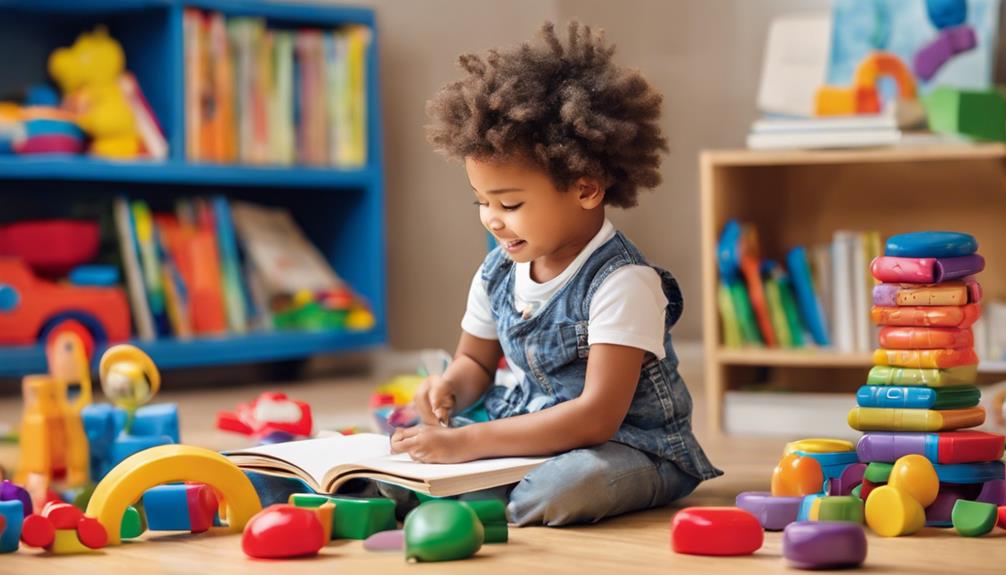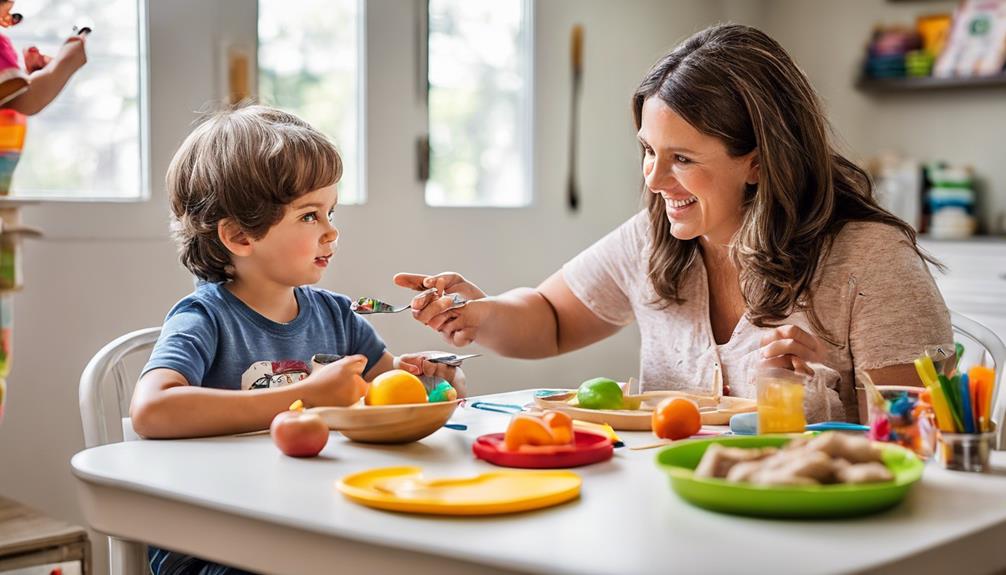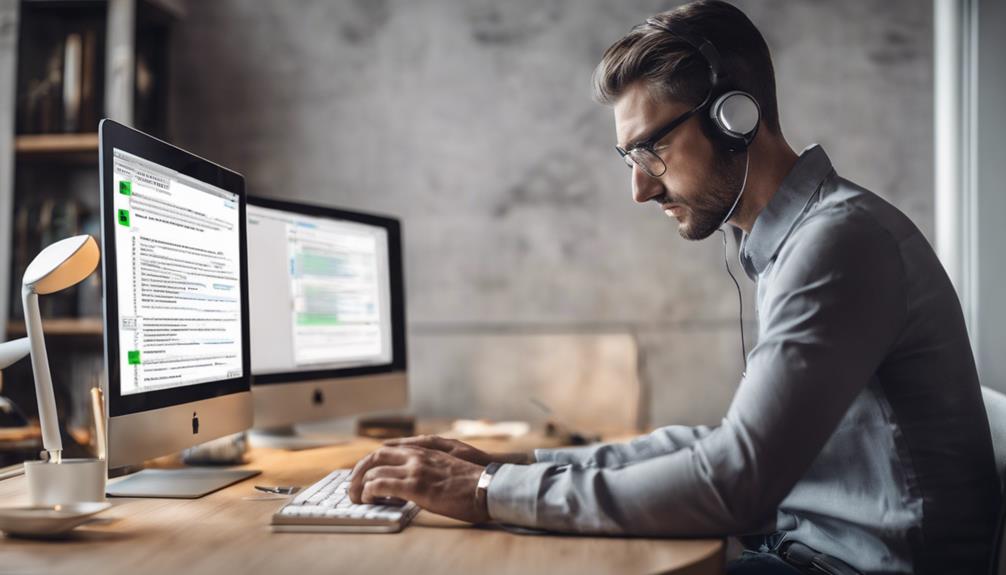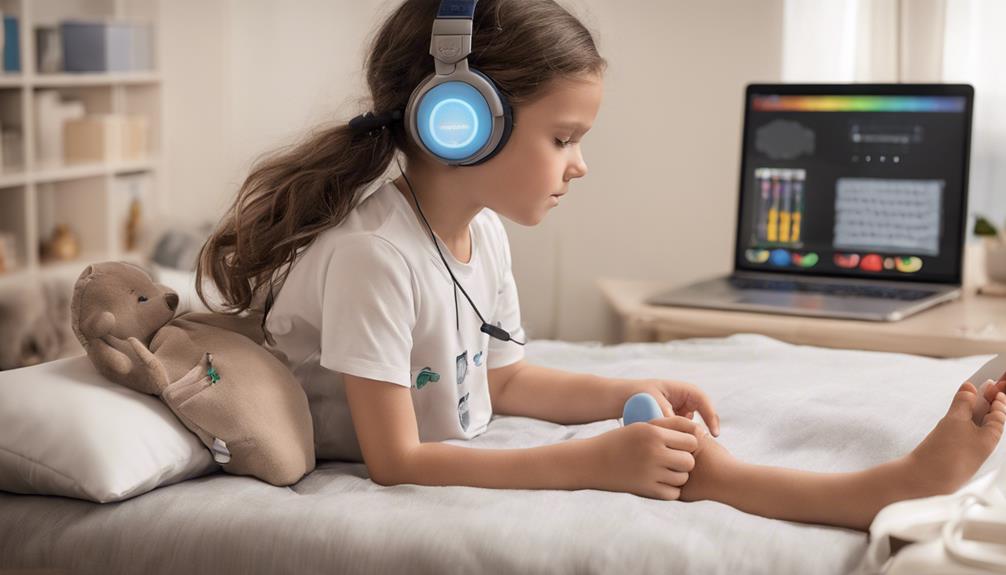As we embark on the journey of unraveling the intricacies of speech therapy tips tailored for preschoolers, we are met with a mosaic of strategies designed to nurture and enhance their language capabilities.
From establishing a structured routine to incorporating elements of movement and music, each tip serves as a building block for fostering effective communication skills in young learners.
The significance of caregiver engagement and the utilization of positive reinforcement techniques hint at a holistic approach to speech therapy, promising a comprehensive guide to optimizing language development in the early years.
Key Takeaways
- Establish a daily routine incorporating speech activities for structure and language modeling.
- Use visual aids to enhance understanding, communication, and foster independence in speech therapy.
- Encourage movement and physical activities to maintain focus, engagement, and fine motor skills development.
- Incorporate toys, play, technology, and social interaction to spark imagination and enhance speech and language skills.
Establish a Daily Routine
Establishing a daily routine is key to providing structure and predictability for preschoolers in speech therapy sessions. Preschool speech therapy thrives on consistency, and a set routine helps children feel secure and understand what to expect during their therapy sessions.
By modeling simple language and incorporating speech activities into daily routines, we create a comfortable environment where children can engage and participate effectively. Specific times for speech activities, breaks, transitions, and play-based learning can be integrated into the daily schedule.
This structured approach not only improves focus and engagement but also supports the development of communication skills and language acquisition in preschoolers. Through a well-established routine, we aim to instill confidence in children and empower them to progress in their speech therapy journey with ease and enthusiasm.
Incorporate Visual Aids

To enhance preschoolers' understanding and engagement during speech therapy sessions, incorporating visual aids is a valuable strategy that promotes communication and independence. Visual aids, such as visual schedules, play a crucial role in helping preschoolers anticipate and comprehend activities within speech therapy sessions. Here are some ways visual aids can benefit preschoolers during their therapy sessions:
- Enhancing Understanding: Visual supports help clarify expectations and guide children through the sequence of activities, making the session more comprehensible.
- Boosting Communication: By providing a visual reference, children can better express their thoughts and feelings, improving their ability to communicate with therapists.
- Fostering Independence: Visual aids empower preschoolers to engage in activities with greater autonomy, promoting self-reliance and confidence.
- Supporting Structure: Visual schedules assist in organizing the session, ensuring smooth transitions between different tasks and keeping children focused throughout.
Incorporating visual aids into speech therapy sessions can significantly enrich the learning experience for preschoolers, facilitating their progress and active participation.
Encourage Movement
Let's explore how movement can enhance speech therapy sessions for preschoolers.
Incorporating physical activities, using gestures and actions, and playing movement-based games can help maintain children's focus and engagement.
These strategies not only support speech therapy goals but also promote fine motor skills development and overall well-being for preschoolers.
Incorporate Physical Activities
Incorporating physical activities into speech therapy sessions for preschoolers is essential for enhancing their focus and attention.
Here are some ways to seamlessly blend speech therapy activities with physical movements:
- Dance Breaks: Integrate short dance sessions to music related to the lesson for a fun and engaging way to reinforce speech sounds.
- Role-Playing: Encourage acting out scenes or using puppets to stimulate language production and creativity.
- Interactive Games: Incorporate games like Simon Says or Red Light, Green Light to promote listening skills and following directions.
- Fine Motor Skills: Use activities like threading beads or coloring to support hand-eye coordination while working on speech goals.
Use Gestures and Actions
Enhancing communication and language development in preschoolers can be achieved through the use of gestures and actions, which encourage movement and non-verbal expression. By incorporating gestures alongside speech, children can better comprehend and engage in interactions. These non-verbal cues provide visual support to verbal communication, aiding in memory retention and learning processes.
Encouraging movement through gestures allows children to express themselves more fully, even when words might be challenging. When speech is combined with physical actions, it creates a multi-sensory experience that can be highly beneficial for preschool-aged children. By actively involving gestures in speech activities, we can create a more dynamic and effective way to support children's speech and language development.
Play Movement-Based Games
Playing movement-based games with preschoolers is a fun and effective way to encourage physical activity and engagement while enhancing their gross motor skills and coordination. By incorporating these activities into speech therapy sessions, children can improve attention, focus, and overall speech development.
Here are four ways movement-based games benefit children's learning:
- Enhanced Motor Skills: Activities like Simon Says and obstacle courses help children develop and refine their gross motor skills.
- Promotes Physical Activity: Games such as musical chairs encourage children to move their bodies, promoting a healthy lifestyle.
- Improved Engagement: Using language during movement-based games enhances the child's learning experience and keeps them actively involved.
- Emotional Regulation: Movement-based games help children release energy and regulate emotions, creating a positive therapeutic environment.
Utilize Music Therapy

Utilizing music therapy in speech sessions with preschoolers can greatly enhance their communication skills and overall engagement. Music therapy engages multiple brain areas, enhancing synapses and emotions in young children, making it a valuable tool for integrating speech therapy techniques in a preschool setting. Music can support various aspects of communication development such as greetings, transitions, and following instructions. Platforms like YouTube offer a wide range of preschool songs that can be beneficial for speech therapy sessions, providing a fun and interactive way to work on language goals.
Incorporating music into therapy sessions can promote engagement, motivation, and language development in preschoolers. The rhythmic and melodic elements of music can captivate children's attention and create a positive and supportive environment for speech therapy activities. By incorporating music therapy techniques, speech therapists can make sessions more enjoyable and effective for preschoolers, ultimately helping them improve their communication skills in a creative and engaging manner.
Foster Communication With Caregivers

Let's focus on the importance of fostering strong communication with caregivers to support the speech development of preschoolers.
Daily communication logs can help us share insights, progress, and challenges in real-time.
Daily Communication Logs
Implementing daily communication logs enhances the collaboration between speech therapists and caregivers, fostering a deeper understanding of the child's progress and needs. Communication logs serve as valuable tools in the speech therapy journey, providing a structured way to track and share crucial information. Here are four ways they benefit both caregivers and therapists:
- Tracking Progress: Logs offer a detailed record of the child's communication goals, achievements, and challenges.
- Consistency at Home: They help ensure that speech activities are practiced consistently at home, promoting continuity between therapy sessions.
- Feedback Loop: Caregivers can provide insightful feedback based on the information in the logs, aiding in tailoring therapy strategies.
- Enhanced Communication: These logs promote transparency and communication among all parties involved, fostering a supportive environment for the child's development.
Collaborate on Strategies
To enhance the effectiveness of speech therapy for preschoolers, fostering open communication with caregivers is essential in collaboratively developing strategies to support the child's speech development. By involving parents in the therapy process, we can create a more holistic approach to helping your child learn. Here is a table outlining some collaborative strategies that can be used to support your child's speech development:
| Collaborative Strategies | Description |
|---|---|
| Regular Communication | Share progress and reinforce therapy goals |
| Home Practice Materials | Provide newsletters and handouts for practice |
| Education on Techniques | Educate parents on speech therapy strategies |
| Active Participation | Encourage parents to engage in speech activities |
| Resource Utilization | Use available resources for parent involvement |
Share Progress Updates
Regularly sharing progress updates with caregivers is crucial for fostering communication and collaboration in a child's speech therapy journey. It allows caregivers to actively participate in the child's development and speech goals. Here are some key reasons why sharing progress updates is vital:
- Transparent Communication: Keeping caregivers informed about the child's progress ensures transparency and allows for open discussions.
- Consistency in Practice: Updates help in maintaining consistency between therapy sessions and practice at home, enhancing the child's language development.
- Empowering Caregivers: Understanding the child's strengths and areas for improvement empowers caregivers to support speech therapy effectively.
- Building a Supportive Network: Collaborating with caregivers creates a supportive network that benefits the child's overall speech and language advancement.
Practice Patience and Expectant Waiting

Let's practice patience and expectant waiting while engaging preschoolers in speech therapy sessions. When a child begins speech and language therapy, it's crucial to allow them time to process information and formulate their thoughts. By practicing patience during moments of silence, we create a supportive environment that encourages the child to initiate communication. Expectant waiting involves giving the child opportunities to actively participate in conversations, fostering their language development.
During speech therapy sessions, using pauses strategically can prompt the child to fill in the conversation, helping them enhance their communication skills. This technique not only builds the child's confidence in expressing themselves but also demonstrates our belief in their abilities. Our patience and expectant waiting play a vital role in nurturing the child's speech and language skills, creating a positive and encouraging atmosphere for their growth. Remember, by allowing the child the time they need to respond, we're supporting their journey towards improved communication abilities.
Implement Positive Reinforcement
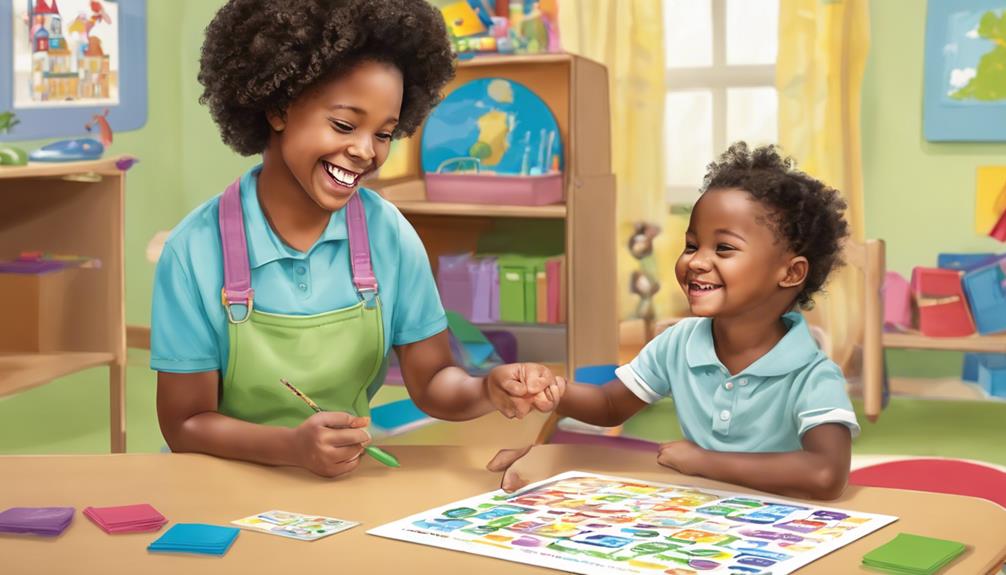
Positive reinforcement plays a crucial role in nurturing preschoolers' communication skills during speech therapy sessions. By implementing positive reinforcement techniques, we can create a supportive and encouraging environment that helps children learn language effectively.
Here are four ways to effectively implement positive reinforcement during speech therapy sessions:
- Specific Praise: Highlight and praise specific desired behaviors such as making efforts to speak or using new words. This boosts the child's confidence and motivates them to engage more in communication.
- Boost Confidence: Specific praise for positive actions helps children understand and internalize speech therapy goals, boosting their confidence in their ability to communicate effectively.
- Encourage Efforts: Encouraging positive behaviors through reinforcement reinforces desired communication skills in preschoolers, making them more likely to continue practicing and improving their language abilities.
- Create a Supportive Environment: Being specific in praising efforts during speech activities fosters a supportive and encouraging learning environment, where children feel motivated to participate and grow in their communication skills.
Explore Sign Language
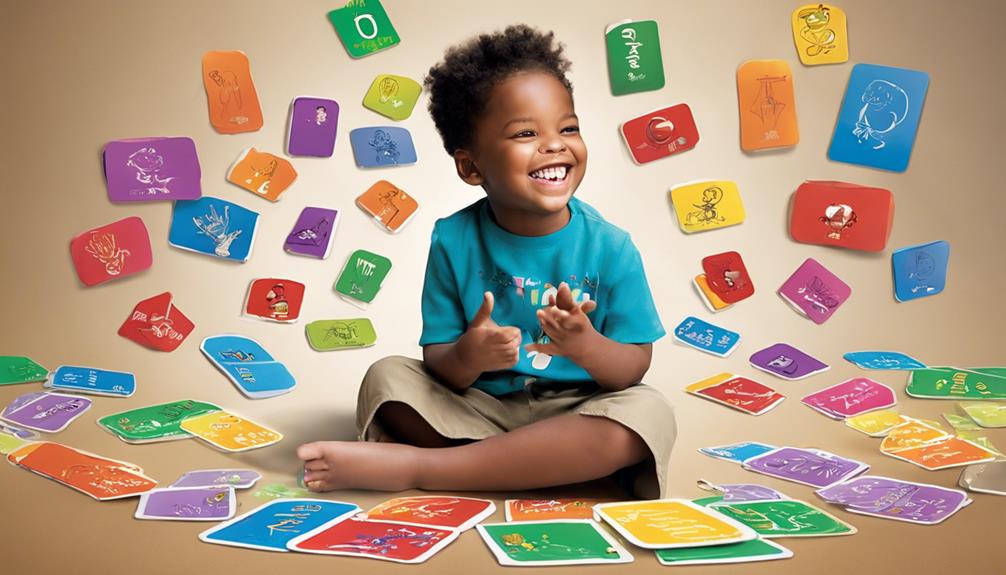
When introducing sign language to preschoolers, we open up a whole new world of communication for them. By incorporating signs like 'more,' 'please,' and 'thank you' into their daily routines, we can enhance their ability to express themselves.
Research supports the idea that using sign language can boost language development and reduce frustration in young children.
Benefits of Signing
Exploring sign language with preschoolers can significantly enhance their communication skills and overall language development. Incorporating signs into daily interactions can bring about numerous benefits for young children:
- Reduces Frustration: Signing provides an alternative mode of communication, helping preschoolers express themselves more effectively and reducing frustration.
- Enhances Language Development: Research indicates that signing can improve vocabulary skills and enhance overall language development in young children.
- Supports Early Literacy: Sign language can aid in developing early literacy skills, laying a strong foundation for reading and writing.
- Facilitates Communication: Introducing signs for common words and concepts can facilitate communication and understanding, particularly for preschoolers with speech delays.
Incorporating Signs Everyday
Incorporating sign language into daily interactions with preschoolers can greatly enhance their communication skills and overall language development. By using signs alongside spoken words, children can make connections between gestures and meanings, improving their vocabulary and expressive language abilities. It's essential to remember that children are always observing and learning, even when not actively participating in a conversation. Here is a practical way to incorporate sign language into daily routines:
| Morning Routine | Mealtime | Bedtime |
|---|---|---|
| Sign "Good Morning" when waking up | Use signs for basic food items like "more," "eat," and "drink" | Sign "Goodnight" before bedtime |
| Sign "Brush teeth" during hygiene activities | Sign "Thank you" when receiving food or drink | Sign "Sleep" before bedtime |
| Sign "Clothes" when getting dressed | Sign "All done" when finished eating | Sign "Story" before reading a bedtime story |
Engage in Play-Based Learning

Utilizing play-based learning techniques in speech therapy sessions for preschoolers enhances communication skills in a natural and engaging manner. Play-based learning is an effective way to help children develop their language skills while having fun.
Here are some tips for incorporating play-based learning into speech therapy sessions:
- Interactive Games: Engage children in activities that require verbal communication, such as board games or interactive storytelling, to promote language use and social interaction.
- Pretend Play: Encourage children to engage in imaginative play scenarios where they can practice using different words and expressions in a playful setting.
- Puzzles and Activities: Use puzzles, matching games, and other hands-on activities to target specific speech goals while keeping the session enjoyable and interactive.
- Toys and Props: Integrate toys and props that spark children's imagination and encourage them to communicate verbally, fostering language development in a fun and stimulating way.
Create a Language-Rich Environment

Surround your preschooler with books, pictures, and labels to create a language-rich environment that nurtures their language development. By immersing children in a variety of language stimuli, they can learn new words and understand how to use words effectively in different contexts. Here is a practical way to foster language development at home:
| Language-Rich Environment Activities | Description |
|---|---|
| Reading Aloud | Read books together, discussing the story and characters. |
| Labeling Objects | Label items in your home to help your child associate words with objects. |
| Storytelling Sessions | Encourage your child to create their own stories and share them with you. |
| Singing Songs | Sing songs with repetitive lyrics to help your child remember words and phrases. |
| Rhyming Games | Play rhyming games to introduce sound patterns and improve phonological awareness. |
Creating a language-rich environment through these activities can significantly support your preschooler's language skills and overall development.
Frequently Asked Questions
How to Do Speech Therapy With Preschoolers?
When working with preschoolers in speech therapy, we engage them through interactive activities tailored to their interests. By offering choices and incorporating movement breaks, we keep sessions fun and engaging.
We use visual, verbal, and modeling cues to support communication development and maintain focus. It's important to create a supportive environment that encourages participation and empowers preschoolers to communicate effectively.
How Can a Preschooler Improve Speech?
Improving speech in preschoolers involves consistent practice and encouragement. By engaging in activities that promote communication and using visual aids, children can develop their speech skills.
Modeling language and creating a language-friendly environment are vital. Caregivers play a crucial role in supporting speech development at home. Encouraging children to communicate and narrate actions helps them enhance their speech abilities.
These strategies can greatly benefit preschoolers in improving their speech.
How Do You Explain Speech Therapy to a Preschooler?
When explaining speech therapy to preschoolers, we focus on helping them learn to speak more clearly and communicate better. We use fun activities and games to make learning enjoyable.
A speech therapist is like a teacher who guides children in practicing sounds, words, and following directions. Through speech therapy, children gain confidence and improve their social and academic skills.
It's all about helping kids express themselves effectively and succeed in various settings.
How Can I Make My 4 Year Old Speech Clear?
We can help your 4-year-old improve speech clarity by practicing specific sounds like /k/, /g/, /s/, /z/, and /r. Ensure proper tongue placement and airflow for accurate articulation. Visual aids, such as mouth diagrams, can demonstrate correct positions.
Engage in activities targeting sound production in isolation, syllables, words, and sentences. For personalized strategies and support, consult a speech-language pathologist.
Let's work together to enhance your child's speech skills effectively.
Conclusion
In building a foundation for speech therapy in preschoolers, we plant seeds of communication that bloom into vibrant language gardens. By nurturing routine, visual aids, movement, music, caregiver involvement, positive reinforcement, sign language, play-based learning, and a language-rich environment, we cultivate strong roots of expressive language skills.
Together, we water these seeds of communication with love and patience, watching as each child blossoms into confident and articulate communicators.

